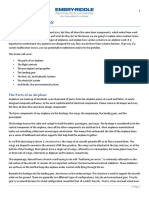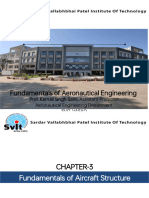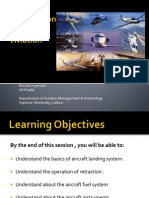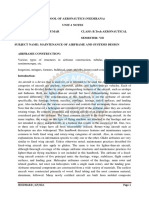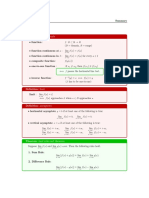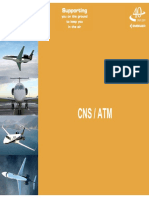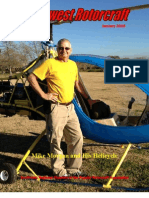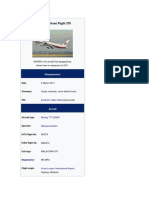0 ratings0% found this document useful (0 votes)
12 viewsMECH3640 Structure
MECH3640 Structure
Uploaded by
Outis WongThe structure of an aircraft consists of two main categories: the airframe and powerplant. The airframe includes the fuselage, wings, and empennage. The fuselage provides the main body and structural support, while the wings generate lift and the empennage provides stability and control surfaces. The powerplant, such as jet engines, provides thrust for flight. Secondary structures like the landing gear, fuel, electrical, hydraulic, and environmental control systems are also essential for aircraft functioning. Together, the carefully designed components work as a system to ensure safe and efficient air travel.
Copyright:
© All Rights Reserved
Available Formats
Download as DOCX, PDF, TXT or read online from Scribd
MECH3640 Structure
MECH3640 Structure
Uploaded by
Outis Wong0 ratings0% found this document useful (0 votes)
12 views2 pagesThe structure of an aircraft consists of two main categories: the airframe and powerplant. The airframe includes the fuselage, wings, and empennage. The fuselage provides the main body and structural support, while the wings generate lift and the empennage provides stability and control surfaces. The powerplant, such as jet engines, provides thrust for flight. Secondary structures like the landing gear, fuel, electrical, hydraulic, and environmental control systems are also essential for aircraft functioning. Together, the carefully designed components work as a system to ensure safe and efficient air travel.
Copyright
© © All Rights Reserved
Available Formats
DOCX, PDF, TXT or read online from Scribd
Share this document
Did you find this document useful?
Is this content inappropriate?
The structure of an aircraft consists of two main categories: the airframe and powerplant. The airframe includes the fuselage, wings, and empennage. The fuselage provides the main body and structural support, while the wings generate lift and the empennage provides stability and control surfaces. The powerplant, such as jet engines, provides thrust for flight. Secondary structures like the landing gear, fuel, electrical, hydraulic, and environmental control systems are also essential for aircraft functioning. Together, the carefully designed components work as a system to ensure safe and efficient air travel.
Copyright:
© All Rights Reserved
Available Formats
Download as DOCX, PDF, TXT or read online from Scribd
Download as docx, pdf, or txt
0 ratings0% found this document useful (0 votes)
12 views2 pagesMECH3640 Structure
MECH3640 Structure
Uploaded by
Outis WongThe structure of an aircraft consists of two main categories: the airframe and powerplant. The airframe includes the fuselage, wings, and empennage. The fuselage provides the main body and structural support, while the wings generate lift and the empennage provides stability and control surfaces. The powerplant, such as jet engines, provides thrust for flight. Secondary structures like the landing gear, fuel, electrical, hydraulic, and environmental control systems are also essential for aircraft functioning. Together, the carefully designed components work as a system to ensure safe and efficient air travel.
Copyright:
© All Rights Reserved
Available Formats
Download as DOCX, PDF, TXT or read online from Scribd
Download as docx, pdf, or txt
You are on page 1of 2
Aircraft structure refers to the components and materials that make up an
aircraft's physical form. These structures are designed to withstand the
stresses and forces of flight, provide stability and control, and protect the
aircraft and its occupants. The structure of an aircraft is divided into two main
categories: the airframe and the powerplant.
The airframe is the main body of the aircraft, and it consists of the fuselage,
wings, and empennage. The fuselage is the central part of the airframe and
provides the main body of the aircraft. It houses the cockpit, passenger and
cargo compartments, and the aircraft's powerplant. The fuselage is usually a
long, narrow tube made of aluminum or composite materials and provides the
structural support for the wings and empennage.
The wings are the primary lifting surfaces of an aircraft and are responsible for
generating the lift needed to keep the aircraft in the air. They are typically
attached to the fuselage and extend out on either side. The shape and design
of the wings play a crucial role in the aircraft's performance, stability, and
control. The wings are usually made of lightweight yet strong materials, such
as aluminum alloy or composite materials, and are designed to withstand the
forces of flight.
The empennage, also known as the tail assembly, is located at the rear of the
aircraft and consists of the horizontal stabilizer, vertical stabilizer, and control
surfaces. The horizontal stabilizer is a fixed wing that helps to keep the aircraft
stable in pitch. The vertical stabilizer is a fixed fin that provides stability in yaw.
The control surfaces, such as the elevator, rudder, and ailerons, are movable
surfaces that allow the pilot to control the aircraft's movement and attitude.
The powerplant of an aircraft refers to the engines and propellers or turbines
that provide the thrust needed for flight. The type and number of engines
depend on the size and purpose of the aircraft. For example, commercial
airliners usually have two or more jet engines, while smaller aircraft may have
a single piston engine. The powerplant is attached to the airframe and is
responsible for providing the necessary speed and lift for takeoff, maintaining
level flight, and powering other systems, such as the electrical and hydraulic
systems.
In addition to the main components of the airframe and powerplant, there are
also various secondary structures and systems that are essential for the overall
functioning of an aircraft. These include the landing gear, fuel system,
electrical system, hydraulic system, and environmental control system.
The landing gear is a set of wheels and struts that allow the aircraft to take off,
land, and taxi on the ground. It is usually retractable and is housed in the
fuselage when not in use. The fuel system is responsible for storing and
delivering fuel to the engines. It consists of fuel tanks, pumps, and lines, and is
carefully designed to prevent fuel leaks and ensure proper fuel distribution.
The electrical system provides power to various systems and components,
such as lights, instruments, and avionics. It includes generators, batteries, and
wires, and is crucial for the safe operation of an aircraft. The hydraulic system
uses pressurized fluid to power various systems, such as the landing gear,
brakes, and flight controls. It provides a reliable and efficient means of
transmitting power and is essential for larger and more complex aircraft.
Lastly, the environmental control system is responsible for maintaining a
comfortable and safe environment for the passengers and crew. It regulates
the temperature, humidity, and pressurization of the aircraft cabin. It also
includes systems such as air conditioning, heating, and oxygen supply.
In conclusion, the structure of an aircraft is a complex and carefully designed
system of components and materials that work together to ensure safe and
efficient flight. From the airframe and powerplant to the secondary structures
and systems, each part has a specific function and is crucial for the overall
performance of the aircraft. The constant advancements in technology and
materials continue to push the boundaries of aircraft design and allow for
faster, safer, and more efficient flight.
分享重試
You might also like
- Aviation Maintenance Technician: PowerplantFrom EverandAviation Maintenance Technician: PowerplantRating: 3.5 out of 5 stars3.5/5 (3)
- Introduction to Fly-By-Wire Flight Control SystemsFrom EverandIntroduction to Fly-By-Wire Flight Control SystemsRating: 5 out of 5 stars5/5 (1)
- Aeronautical Project Report On Aircraft StructureDocument12 pagesAeronautical Project Report On Aircraft StructuresumanbabaNo ratings yet
- Helicopter Flying Handbook (2024): FAA-H-8083-21BFrom EverandHelicopter Flying Handbook (2024): FAA-H-8083-21BRating: 4.5 out of 5 stars4.5/5 (3)
- Dauphin II Flight Manual PDFDocument32 pagesDauphin II Flight Manual PDFvanmorrison69100% (1)
- Aircraft StructureDocument11 pagesAircraft StructureVagesh VagesNo ratings yet
- Chapter - 4 - Electric Power Supply Systems of Aircraft - 2021Document17 pagesChapter - 4 - Electric Power Supply Systems of Aircraft - 2021Vlada LagutenkoNo ratings yet
- Aircraft Systems: The Parts of An AirplaneDocument11 pagesAircraft Systems: The Parts of An AirplaneTariq TaeemNo ratings yet
- 1.PPT-3130108-3Document27 pages1.PPT-3130108-3ayushsolanki035No ratings yet
- Basic Aircraft StructureDocument47 pagesBasic Aircraft Structurekhagendrakryadav100% (7)
- Ve Unit 4Document16 pagesVe Unit 4vamshimohanNo ratings yet
- AirplaneDocument1 pageAirplaneLNNo ratings yet
- Aircraft Structure - An Introduction To Major Airplane ComponentsDocument9 pagesAircraft Structure - An Introduction To Major Airplane ComponentsPj BaroesNo ratings yet
- Kuntal Barik Cse B 14200121139Document7 pagesKuntal Barik Cse B 14200121139nikag20106No ratings yet
- TPK Slide 2 Lazuardy Daring 2021Document19 pagesTPK Slide 2 Lazuardy Daring 2021Renanto SuryadinataNo ratings yet
- Hal ReporDocument19 pagesHal ReporAkashNo ratings yet
- 2 - Aircraft Flight Control SystemDocument45 pages2 - Aircraft Flight Control SystemAkmal Sulhan TardohNo ratings yet
- Aircraft Structure 2Document4 pagesAircraft Structure 2raj mohanNo ratings yet
- Ae8751 - Avionics: Unit I Introduction To AvionicsDocument86 pagesAe8751 - Avionics: Unit I Introduction To AvionicsKannan100% (1)
- Basicaircraftstructure 110325070203 Phpapp02Document36 pagesBasicaircraftstructure 110325070203 Phpapp02yinkaakins2001No ratings yet
- Aircraft StructureDocument10 pagesAircraft StructureAdi Putra100% (1)
- Pilot's Encyclopedia of Aeronautical Knowledge: Federal Aviation AdministrationFrom EverandPilot's Encyclopedia of Aeronautical Knowledge: Federal Aviation AdministrationRating: 4 out of 5 stars4/5 (18)
- Primary Flight Control SurfacesDocument7 pagesPrimary Flight Control SurfacesVignesh DuraiNo ratings yet
- System ModuleDocument9 pagesSystem Modulekeeno manzanoNo ratings yet
- Chap 2 Aeronefs StructureDocument7 pagesChap 2 Aeronefs Structureismain.niniNo ratings yet
- Ringka, Dzharl - Activity 1Document3 pagesRingka, Dzharl - Activity 1Dzharl RingkaNo ratings yet
- The Fascinating World of Aircraft A Look Into The Main PartsDocument8 pagesThe Fascinating World of Aircraft A Look Into The Main Partsersain05.krgNo ratings yet
- Extended ProjectDocument16 pagesExtended Projectrazanalmstkawi1No ratings yet
- Structural ComponentsDocument29 pagesStructural ComponentsCed SisonNo ratings yet
- Aeronautical Structures PDFDocument56 pagesAeronautical Structures PDFGiovanni OrnelasNo ratings yet
- Sourish Kundu Control Seminar Report 002010801105Document41 pagesSourish Kundu Control Seminar Report 002010801105Sourish KunduNo ratings yet
- Landing Gear, Aircraft Fuel Systems - Lec 4Document61 pagesLanding Gear, Aircraft Fuel Systems - Lec 4aahsan345No ratings yet
- Aircraft StructuresDocument3 pagesAircraft StructuresVarun Karthikeyan ShettyNo ratings yet
- Proyecto de Ingles 4Document12 pagesProyecto de Ingles 4manuelNo ratings yet
- Amt 1202 Assignment PrelimsDocument1 pageAmt 1202 Assignment Prelimsjoeffrey.jimenez.cvtNo ratings yet
- Aircraft Construction and MaterialsDocument4 pagesAircraft Construction and Materialsgalaxy_hypeNo ratings yet
- SH ReportDocument96 pagesSH ReportjoelawrenceNo ratings yet
- Amt 4101 Activity 2Document15 pagesAmt 4101 Activity 2Brendan Lewis DelgadoNo ratings yet
- Texte Colocviu AeroDocument5 pagesTexte Colocviu AeroDiana PuiuNo ratings yet
- 14014A ch4Document26 pages14014A ch4Sajjad ShamimNo ratings yet
- IJEET 07 05 009 PDFDocument34 pagesIJEET 07 05 009 PDFrobertNo ratings yet
- Aircraft Hydraulic Systems Can Be A Challenge To Design EngineersDocument3 pagesAircraft Hydraulic Systems Can Be A Challenge To Design EngineersmatiasNo ratings yet
- Aircraft Instruments: Learning ObjectivesDocument88 pagesAircraft Instruments: Learning ObjectivesjhNo ratings yet
- Aircraftsystemstech Flight Control Surfaces DirectionalDocument9 pagesAircraftsystemstech Flight Control Surfaces DirectionalKiril NedkovNo ratings yet
- AENG 513-3: Assignment No. 3Document6 pagesAENG 513-3: Assignment No. 3Paul GernahNo ratings yet
- MaintenanceDocument4 pagesMaintenancesyedumarahmed52No ratings yet
- Wing PlanformDocument12 pagesWing PlanformBogdan Ionut HruscaNo ratings yet
- Aircraft PerformanceDocument29 pagesAircraft PerformanceRajiv Vutukuri100% (1)
- Lecture No. 1Document41 pagesLecture No. 121-09942No ratings yet
- Pneumatic Systems, Bleed Air - Lecture 7Document18 pagesPneumatic Systems, Bleed Air - Lecture 7aahsan345No ratings yet
- Basicaircraftstructure 110325070203 Phpapp02Document36 pagesBasicaircraftstructure 110325070203 Phpapp02Kv PavanNo ratings yet
- Aircraft Instrumentation Notes 1st UnitDocument12 pagesAircraft Instrumentation Notes 1st UnitSantosh KumarNo ratings yet
- Aircraft Landing Gear System: Presented By: Rishikesh K. Singh Roll No. 134103054 Guided by Dr. Ujjwal Kumar SahaDocument39 pagesAircraft Landing Gear System: Presented By: Rishikesh K. Singh Roll No. 134103054 Guided by Dr. Ujjwal Kumar SahaindahNo ratings yet
- Aircraft Flight Control SystemsDocument11 pagesAircraft Flight Control SystemsBhupendra SinghNo ratings yet
- Aircraft Control SystemsDocument119 pagesAircraft Control SystemsSanju Sahu100% (2)
- Aircraft Control SystemDocument145 pagesAircraft Control Systemabdel4aliNo ratings yet
- 7an6.3 Maintenance of Airframe and Systems Design Unit I&iiDocument56 pages7an6.3 Maintenance of Airframe and Systems Design Unit I&iipriyankaNo ratings yet
- Fly by Wire ConceptDocument20 pagesFly by Wire ConceptSanjay RameshNo ratings yet
- Aircraft Landing Gear System: Presented By: Rishikesh K. Singh Roll No. 134103054 Guided by Dr. Ujjwal Kumar SahaDocument39 pagesAircraft Landing Gear System: Presented By: Rishikesh K. Singh Roll No. 134103054 Guided by Dr. Ujjwal Kumar SahaShravan Bunny DuaNo ratings yet
- Task Report - RAMADocument11 pagesTask Report - RAMADharmendra PatelNo ratings yet
- Introduction to Fly-by-Wire Flight Control Systems: The professional pilot’s guide to understanding modern aircraft controlsFrom EverandIntroduction to Fly-by-Wire Flight Control Systems: The professional pilot’s guide to understanding modern aircraft controlsNo ratings yet
- 2350 wksht05 SolDocument6 pages2350 wksht05 SolOutis WongNo ratings yet
- 2350 wksht06 SolDocument3 pages2350 wksht06 SolOutis WongNo ratings yet
- (MATH2350) (2018) (F) Midterm Schenci 74056Document11 pages(MATH2350) (2018) (F) Midterm Schenci 74056Outis WongNo ratings yet
- (Civl253) (2010) (F) Midterm Wmma 10066Document9 pages(Civl253) (2010) (F) Midterm Wmma 10066Outis WongNo ratings yet
- (ELEC2420) (2015) (F) Final Brilkjdd 93583Document15 pages(ELEC2420) (2015) (F) Final Brilkjdd 93583Outis WongNo ratings yet
- MECH2210 Tutorial 5 SolutionDocument13 pagesMECH2210 Tutorial 5 SolutionOutis WongNo ratings yet
- Tutorial 08 SolutionDocument13 pagesTutorial 08 SolutionOutis WongNo ratings yet
- MECH1907 Quiz Spring 2022 2Document5 pagesMECH1907 Quiz Spring 2022 2Outis WongNo ratings yet
- Tutorial 05 06 SolutionDocument19 pagesTutorial 05 06 SolutionOutis WongNo ratings yet
- MECH1907 Observation Spring 2022 5Document4 pagesMECH1907 Observation Spring 2022 5Outis WongNo ratings yet
- MECH1907 Workshop Fall 2021 9Document4 pagesMECH1907 Workshop Fall 2021 9Outis WongNo ratings yet
- MECH1907 Pilot Study Spring 2021 5Document5 pagesMECH1907 Pilot Study Spring 2021 5Outis WongNo ratings yet
- MECH1907 Literature Review Fall 2022 5Document5 pagesMECH1907 Literature Review Fall 2022 5Outis WongNo ratings yet
- MECH1907 Poster Winter 2022 3Document4 pagesMECH1907 Poster Winter 2022 3Outis WongNo ratings yet
- MECH1907 HW Fall 2024 1Document5 pagesMECH1907 HW Fall 2024 1Outis WongNo ratings yet
- MECH1907 Outline Fall 2021 4Document4 pagesMECH1907 Outline Fall 2021 4Outis WongNo ratings yet
- Calculus For Scientists and Engineers With Matlab Summary PDFDocument33 pagesCalculus For Scientists and Engineers With Matlab Summary PDFOutis WongNo ratings yet
- MECH3640 AirfoilDocument1 pageMECH3640 AirfoilOutis WongNo ratings yet
- MECH1907 Case Study Winter 2024 3Document4 pagesMECH1907 Case Study Winter 2024 3Outis WongNo ratings yet
- Calculus For Scientists and Engineers With Matlab PDFDocument455 pagesCalculus For Scientists and Engineers With Matlab PDFOutis WongNo ratings yet
- MECH1907 Interview Spring 2022 10Document4 pagesMECH1907 Interview Spring 2022 10Outis WongNo ratings yet
- Airplane Design Manual - TeichmannDocument501 pagesAirplane Design Manual - TeichmannJanus Pacis100% (3)
- Flight Operations PanelDocument47 pagesFlight Operations PanelBill KyaneNo ratings yet
- Tcas BookletDocument45 pagesTcas BookletArun VinthanNo ratings yet
- News Parking and Storage Return To Service Summary LetterDocument57 pagesNews Parking and Storage Return To Service Summary LetterРоман ДяченкоNo ratings yet
- SF50 Vision Jet Flight ManualV8Document85 pagesSF50 Vision Jet Flight ManualV8Rodrigo LossNo ratings yet
- Gps Adirs Nav CBTDocument125 pagesGps Adirs Nav CBTKamalVirk100% (4)
- Design and Development of RakeDocument22 pagesDesign and Development of RakeNiconicoNo ratings yet
- Aetc Sheppard Afb Texas T 6 Aib Narrative Report 2Document36 pagesAetc Sheppard Afb Texas T 6 Aib Narrative Report 2Felipe VieiraNo ratings yet
- HESNDocument15 pagesHESNAli 35100% (1)
- Presentation ATR 72-500Document13 pagesPresentation ATR 72-500Naveed AhmadNo ratings yet
- CPS RFG PilotDocument1 pageCPS RFG Pilotahmed4dodiNo ratings yet
- How Is An Aircraft Built?Document9 pagesHow Is An Aircraft Built?blackghostNo ratings yet
- Southwest RotorcraftDocument13 pagesSouthwest RotorcraftyetinegroNo ratings yet
- Curtiss Model D PusherDocument9 pagesCurtiss Model D PusherAviation/Space History LibraryNo ratings yet
- Malaysia Airlines Flight 370Document3 pagesMalaysia Airlines Flight 370dinosaur x-drakeNo ratings yet
- Sikorsky S-76 - WikipediaDocument11 pagesSikorsky S-76 - WikipediaAmy KlezanNo ratings yet
- 777 Load SheetDocument2 pages777 Load Sheetjcsk8No ratings yet
- Analysis Calculation Performance Engine Turbofan Cfm56Document8 pagesAnalysis Calculation Performance Engine Turbofan Cfm56AswanTajuddin100% (1)
- Attachment 1 - Comparison Between Easa Amc and Altmoc For Ara - Fcl.300 (B) Examination ProceduresDocument15 pagesAttachment 1 - Comparison Between Easa Amc and Altmoc For Ara - Fcl.300 (B) Examination ProceduresafdsfagadgNo ratings yet
- AutomaticDocument36 pagesAutomatictumbNo ratings yet
- Maximum Flaps/Slats Speed: Lever Ecam Max Speed PhaseDocument2 pagesMaximum Flaps/Slats Speed: Lever Ecam Max Speed PhaseJuan Pablo Montoya MNo ratings yet
- US4377052 - Paper PlaneDocument6 pagesUS4377052 - Paper PlaneZeljko LekovicNo ratings yet
- Full Table Report 2307637Document3 pagesFull Table Report 2307637DESPACHO MIQNo ratings yet
- 17Document5 pages17Jai DeepNo ratings yet
- Pilot RefDocument3 pagesPilot Refvikash_kumar_thakurNo ratings yet
- B-767 MmelDocument229 pagesB-767 MmelUnited320100% (1)
- Facetmobile FMXDocument8 pagesFacetmobile FMXФедя ФедяNo ratings yet
- AOM 2020-13 - RiskDocument21 pagesAOM 2020-13 - RiskKaung MyatToeNo ratings yet
- WXR ProcessorDocument3 pagesWXR Processorskater3 laterNo ratings yet







